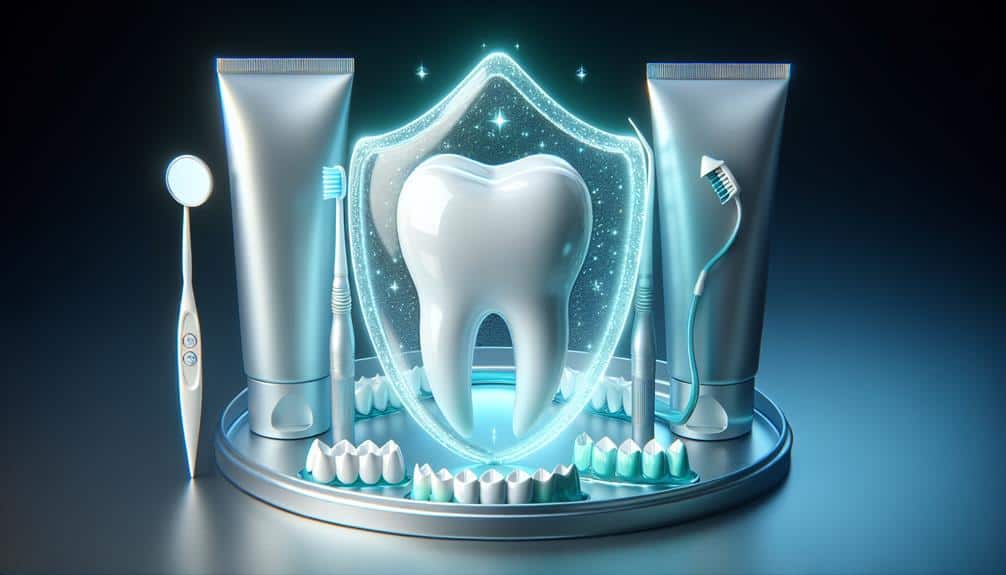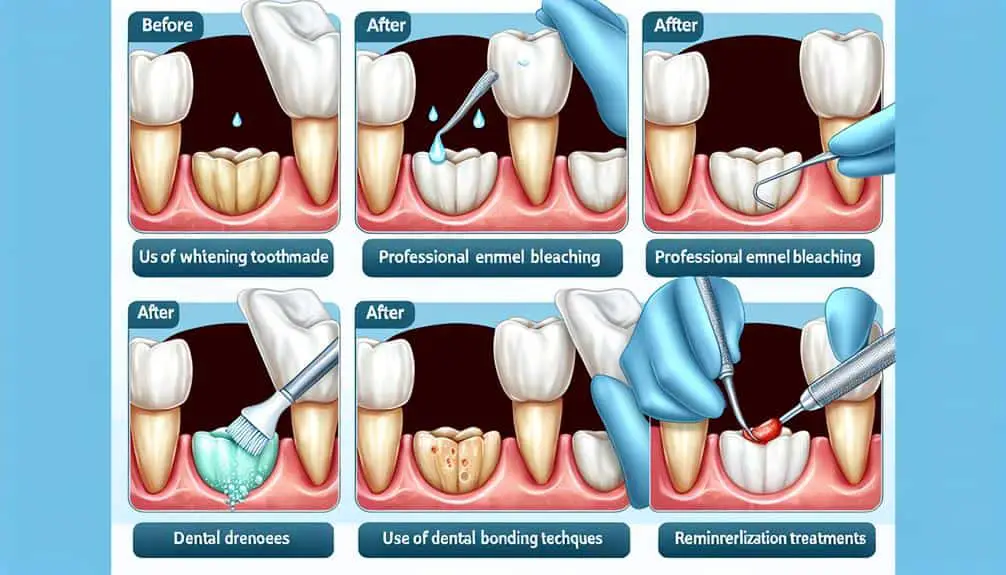To protect your enamel while achieving a brighter smile, consider professional dental whitening treatments. Consult with a dentist for safe and effective methods utilizing concentrated bleaching agents for immediate results. For at-home options, try enamel-friendly whitening kits with desensitizing agents for comfort and prolonged effects. Natural remedies like fruit-based alternatives and baking soda scrubs offer gentle whitening. Look into charcoal toothpaste or LED whitening treatments for more advanced options. Each method emphasizes enamel protection and effective results, ensuring a radiant smile while safeguarding your teeth.
Key Points
- Professional Dental Whitening with monitored treatments for enamel safety.
- At-Home Whitening Kits with enamel-friendly ingredients for effective results.
- Natural Fruit-Based Remedies for gentle enamel protection during whitening.
- Whitening Strips and Fluoride Toothpaste combination for enamel strengthening.
- Whitening Mouthwash with fluoride benefits for enamel health and whitening.
Professional Dental Whitening
When considering professional dental whitening, consult with your dentist to guarantee the most effective and safe treatment for achieving a brighter smile. Professional whitening, also known as dental bleaching, is a popular cosmetic dental procedure that can greatly enhance the appearance of your teeth.
During a professional whitening session, your dentist will apply a bleaching agent to your teeth, which helps to remove stains and discoloration.
Professional whitening procedures are carefully monitored by dental professionals to ensure the safety of your teeth and gums. The concentration of the bleaching agent used in professional treatments is higher than that found in over-the-counter products, leading to more immediate and noticeable results. Additionally, your dentist can customize the treatment to suit your individual needs and address any specific concerns you may have.
At-Home Whitening Kits
When contemplating at-home whitening kits, it's essential to understand their effectiveness in brightening your smile.
Tips on the proper application of these kits can help you achieve successful results.
Knowing the enamel-friendly ingredients to look for in these products is vital for maintaining the health of your teeth.
Kit Effectiveness Explained
To understand the effectiveness of at-home whitening kits, it's essential to evaluate their ingredients and application methods. When considering these kits, keep in mind the following:
- Sensitivity Prevention: Look for kits with desensitizing agents to prevent discomfort during and after whitening.
- Enamel Protection: Opt for kits that provide enamel-safe ingredients to safeguard your teeth.
- Long Term Results: Choose kits that offer gradual whitening for more sustainable outcomes.
- Whitening Longevity: Select kits that come with maintenance treatments to prolong the whitening effects.
Application Tips for Success
For optimal results with at-home whitening kits, ensure precise application techniques to maximize effectiveness and minimize potential risks.
Start by mastering proper brushing techniques to guarantee even coverage of the whitening gel on all tooth surfaces. If you experience tooth sensitivity, consider using a toothpaste for sensitive teeth before whitening to help reduce discomfort.
Follow the recommended timing considerations closely – leaving the gel on for too long can lead to increased sensitivity without providing additional benefits.
After treatment, avoid consuming staining foods or drinks for at least 24 hours, and steer clear of tobacco products.
Practicing good post-treatment care, such as maintaining excellent oral hygiene and attending regular dental check-ups, will help preserve your whitening results for longer.
Enamel-Friendly Ingredients Guide
To safeguard your enamel during at-home teeth whitening, prioritize selecting kits with enamel-friendly ingredients. When choosing at-home whitening kits, opt for those that contain enamel fortifying toothpaste to promote overall enamel health.
Additionally, consider fluoride-free options to prevent any potential enamel erosion. Maintaining an enamel-protective diet is essential; include calcium-rich foods like dairy products, leafy greens, and almonds to support enamel remineralization.
Look for whitening kits that are formulated with these enamel-friendly ingredients to make certain you achieve a brighter smile without compromising the health of your enamel.
Natural Whitening Remedies
Explore the benefits of fruit-based whitening options and the advantages of using baking soda as a natural remedy for teeth whitening.
Discover how incorporating these natural ingredients into your oral care routine can help brighten your smile without harming your enamel.
Consider these gentle and effective alternatives to traditional whitening methods for a more natural approach to achieving a brighter smile.
Fruit-Based Whitening Options
Fruit-derived whitening methods offer a natural alternative for enhancing the brightness of your teeth while safeguarding enamel integrity. When considering fruit-based whitening options, here are some key points to keep in mind:
- Citrus Extracts: Known for their effectiveness in breaking down stains and brightening teeth.
- Berry Enzymes: These enzymes found in berries can help remove surface stains and promote a whiter smile.
- Pineapple: Contains bromelain, an enzyme that can help whiten teeth naturally.
- Papaya: Contains papain, another enzyme that can aid in breaking down stains for a brighter smile.
These fruit-based options can be a gentle yet effective way to whiten your teeth naturally while being mindful of enamel protection.
Baking Soda Benefits
When seeking natural whitening remedies to protect your enamel, consider the advantages of utilizing baking soda. Baking soda, or sodium bicarbonate, is a gentle abrasive that can help eliminate surface stains from your teeth without causing harm to your enamel. Its alkaline nature also aids in balancing the pH level in your mouth, creating an environment less conducive to the growth of bacteria that can lead to tooth decay.
When using baking soda for teeth whitening, employing proper brushing techniques is crucial to prevent enamel erosion. DIY recipes incorporating baking soda can be effective, but ensure safe application by using it in moderation to avoid sensitivity. With its enamel-safe properties, baking soda can be a valuable addition to your natural teeth whitening routine.
Charcoal Toothpaste
Using charcoal toothpaste is a popular method for teeth whitening that has gained attention in recent years. This trend has sparked various discussions regarding its efficacy and safety. Let's explore the facts surrounding charcoal toothpaste:
- Charcoal Toothpaste Myths: There are misconceptions that charcoal toothpaste is abrasive and harmful to enamel, but studies have shown that when used correctly, it can be gentle on teeth.
- Charcoal Toothpaste Safety: Contrary to some beliefs, charcoal toothpaste is generally safe for use. However, it's crucial to select products with fluoride to guarantee enamel protection.
- Activated Charcoal Benefits: Activated charcoal in toothpaste can help eliminate surface stains and toxins from the mouth, contributing to a brighter smile.
- Usage Recommendations: To maximize the benefits of charcoal toothpaste, it's advised to use it in moderation and alongside regular fluoride toothpaste for thorough dental care.
When used appropriately, charcoal toothpaste can be a valuable addition to your oral care routine, aiding in teeth whitening without compromising enamel health.
Whitening Strips
For effective teeth whitening, consider incorporating whitening strips into your oral care routine. Whitening strips are thin, flexible plastic strips coated with a whitening gel that contains peroxide. When applied to your teeth, the gel works to bleach away stains and discoloration. To maximize the effectiveness of whitening strips, it's important to first brush your teeth with whitening toothpaste using proper brush technique. This helps remove any surface stains and allows the whitening strips to work more efficiently.
While using whitening strips, it's vital to also focus on fluoride protection and enamel care. Fluoride is beneficial for strengthening enamel and protecting teeth against decay. Before applying whitening strips, make sure your teeth are clean and dry. Place the strips evenly on your teeth, avoiding the gum line. Follow the recommended usage time to prevent potential enamel damage or tooth sensitivity. Remember, consistent and correct use of whitening strips can lead to a brighter smile while maintaining enamel health.
Whitening Mouthwash
Enhance your oral care routine with Whitening Mouthwash to help maintain a brighter smile.
This type of mouthwash is formulated to target stains and discoloration on your teeth, offering a convenient way to whiten your teeth without causing harm to your enamel.
To maximize its benefits, follow the proper usage instructions provided on the product packaging for best results.
Mouthwash Benefits
To maintain a bright smile while protecting your enamel, incorporating whitening mouthwash into your daily oral care routine can offer additional benefits.
Whitening mouthwash provides more than just a cosmetic enhancement; it also contributes to your overall oral health. Here are some key advantages of using whitening mouthwash:
- Fluoride Benefits: Strengthening enamel and preventing tooth decay.
- Gum Health: Promoting healthy gums and reducing the risk of gum disease.
- Alcohol-Free Options: Avoiding the drying effect of alcohol-based mouthwashes.
- Sensitivity Relief: Alleviating tooth sensitivity while whitening your smile.
Proper Usage Instructions
Consider incorporating whitening mouthwash into your daily oral care routine to effectively brighten your smile while safeguarding your enamel.
To maximize its benefits, make sure you follow proper brushing techniques before using the mouthwash. Brush gently in circular motions for at least two minutes to remove any plaque or debris from your teeth. After brushing, rinse your mouth with water before using the whitening mouthwash.
Timing is essential; follow the instructions on the mouthwash packaging carefully to avoid overuse, which could lead to enamel damage. To protect your enamel and avoid sensitivity, don't use whitening mouthwash immediately after consuming acidic foods or beverages.
Incorporating these practices will help you achieve a whiter smile while maintaining top enamel health.
Baking Soda Scrubs
For a gentle yet effective approach to teeth whitening, incorporating baking soda scrubs into your oral care routine can help remove surface stains and brighten your smile. Baking soda, or sodium bicarbonate, has natural whitening properties that can be harnessed through simple DIY scrub recipes.
Here are some key points to take into account:
- Natural Whitening: Baking soda acts as a mild abrasive, gently scrubbing away surface stains on your teeth to reveal a brighter smile.
- Balanced pH Levels: Baking soda helps balance the pH levels in your mouth, creating an environment less conducive to the growth of bacteria that can cause discoloration.
- Plaque Removal: The exfoliating benefits of baking soda can aid in removing plaque buildup, which is a common cause of yellowing on teeth.
- Fresh Breath: Baking soda's ability to neutralize acids can also help freshen your breath by reducing odor-causing bacteria in the mouth.
Incorporating baking soda scrubs into your dental routine can be a cost-effective and natural way to enhance the whiteness of your teeth while promoting oral health.
Hydrogen Peroxide Rinse
Utilize hydrogen peroxide rinse as a potent method for enhancing teeth whitening and promoting oral hygiene. Hydrogen peroxide is a common ingredient in many teeth whitening products due to its ability to break down stains effectively. When using hydrogen peroxide as a mouth rinse, it's important to follow peroxide safety precautions to prevent any potential harm.
To guarantee the safe use of hydrogen peroxide for teeth whitening, it's recommended to dilute it with water to reduce its concentration. A common guideline is to mix equal parts of 3% hydrogen peroxide with water. Additionally, it's vital to avoid swallowing the rinse and to rinse your mouth thoroughly with water afterward.
While hydrogen peroxide can be effective in whitening teeth, it's important to balance its benefits with enamel protection strategies. To safeguard your enamel, consider using fluoride toothpaste, maintaining proper oral hygiene practices, and consulting with your dentist regularly. By integrating peroxide safety precautions and enamel protection strategies, you can optimize the benefits of hydrogen peroxide rinse for a brighter smile while safeguarding your oral health.
Oil Pulling
Implementing the ancient practice of oil pulling can be a beneficial addition to your oral hygiene routine for promoting dental health and potentially whitening your teeth. Oil pulling involves swishing oil around in your mouth to remove bacteria and promote oral health.
Here are some key points to keep in mind:
- Coconut oil benefits, drawbacks: Coconut oil is a popular choice for oil pulling due to its antimicrobial properties, which can help reduce harmful bacteria in the mouth. However, some people may find the taste or texture of coconut oil unpleasant.
- Sesame oil technique, results: Sesame oil is another oil commonly used for oil pulling. It has been shown to reduce plaque and improve overall oral health. When using sesame oil for oil pulling, make sure to swish it around in your mouth for about 15-20 minutes before spitting it out.
Oil pulling can be a natural way to enhance your oral health, but it's essential to remember that it shouldn't replace regular brushing and flossing.
LED Whitening Treatments
To enhance the whitening of your teeth, contemplate exploring the effectiveness of LED whitening treatments as a modern approach to achieving a brighter smile. LED whitening is known for its effectiveness in removing stains and discoloration from the teeth. The treatment involves the use of a specialized LED light that activates the whitening agent applied to your teeth, accelerating the whitening process. Compared to traditional whitening methods, LED treatments are often faster and can provide noticeable results in a single session.
When it comes to LED whitening, like any dental procedure, there are some risks to ponder. While LED treatments are generally safe, some people may experience tooth sensitivity or gum irritation following the procedure. It's vital to consult with a dental professional before undergoing any whitening treatment to make sure it's suitable for you.
In terms of cost comparison, LED whitening treatments can vary depending on the provider and location. On average, LED whitening may cost more upfront compared to at-home whitening kits, but the results are often more immediate and long-lasting. Consider weighing the benefits and costs to determine if LED whitening is the right choice for you.
Frequently Asked Questions
Can Teeth Whitening Methods Cause Tooth Sensitivity?
Yes, teeth whitening methods can cause tooth sensitivity, especially with some whitening products. Prioritize enamel protection by choosing gentle whitening options. Consult with your dentist for recommendations to achieve best whitening results without compromising enamel health.
How Long Do the Effects of Teeth Whitening Typically Last?
To maintain teeth whitening results, consistent care is key. The longevity of effects varies based on habits and treatments. Regular touch-ups and proper oral hygiene contribute to sustained brightness. Consult your dentist for personalized guidance.
Are There Any Risks or Side Effects Associated With Using Natural Whitening Remedies?
When considering natural remedies for teeth whitening, it's important to weigh effectiveness and safety. While these options can work, there are risks and potential side effects. Always take precautions and consult with a dental professional.
Can Charcoal Toothpaste Cause Damage to Tooth Enamel?
When using charcoal toothpaste, remember it's abrasive nature. It can remove surface stains but may damage enamel if used excessively. Protect your enamel by limiting use and consulting your dentist for alternative whitening methods.
Is LED Whitening Treatment Safe for Individuals With Sensitive Teeth?
LED whitening treatment is effective for brightening teeth. If you have sensitive teeth, consult your dentist for precautions. It's crucial to guarantee safety and minimize discomfort during the whitening process. Prioritize your oral health.



